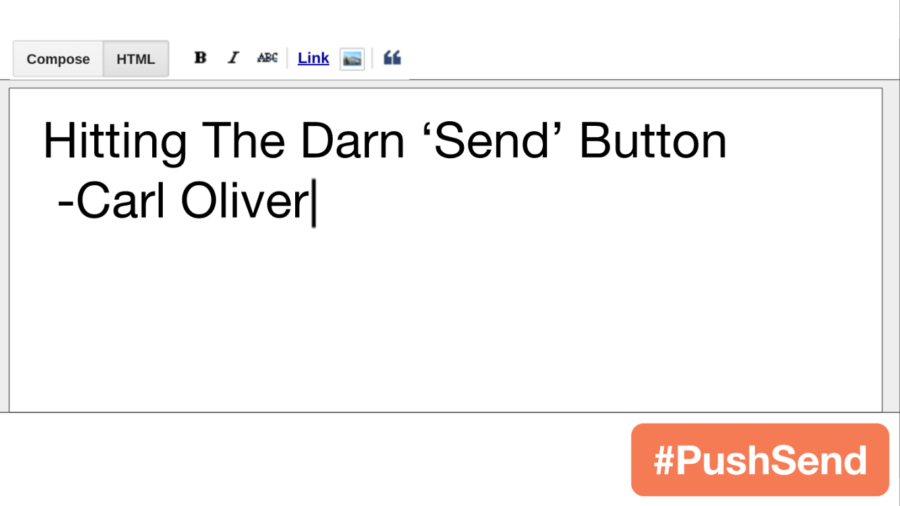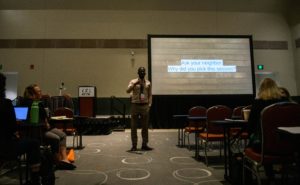So there I was enjoying time with fellow TMC newbies at a dinner. We had just finished singing Moana’s theme when my attention was drawn to my phone by a recent new blog post that read like a charge to fracture end of the group that I was happy to be dining with, or at least the name that the group has called itself for the last 4 years. I had trouble making sense of what this was, and naturally assumed it was a broadside at the whole thing. So I replied…
…and then my phone died. And my phone backup charger was at the hotel.
Because of that I had some time to think and reflect as I waited for the check, and to get on the bus, and to get up to my room. Reflection seemed good, so I kept reflecting, and decided to write this post instead to organize my thoughts.
First off, I’m going to assume the best of intentions behind Dan Meyer’s post. The name #MTBoS is confusing. If the name was easier, it would make it easier for people to understand what is going on. There is a larger world of Math teachers who exist outside of the hashtag and perhaps creating a new one will help those teachers connect to the ones who are currently inside of #MTBoS, and because we all think #MTBoS is great for teaching, that influx will help improve math teaching as a whole. That is my positive ‘reframe’ of the claim, I think it makes sense.
However, the post “Let’s retire #MTBoS.” can be heard as kind of inflammatory, and perhaps be interpreted as having some potentially stark conclusions. It is hard to interpret what someone else on the internet is saying, and instead of trying to psychoanalyze why this came out, and how it came out, I’m going to talk about the only interpretation of this that makes sense. That this is a strongly worded tweet and post to start a conversation that will eventually lead to a community-wide decision about a contentious issue.
If this is to be a conversation, and eventually a decision, then we should have a conversation about process. If things are going to be decided, it’s good to include the stakeholders in the decision. At least in part. With the internet it’s very easy to put out a conversation to talk about an idea, but how do you come to a decision? What are the norms of the group and how does everyone’s opinion get heard? The internet is rife with really bad examples of this. Other online communities have conversation full of strong positions, selective listening, name calling and worse. If this community is going to go the process of conversation and making everyone feel heard, it will probably require some kind of clear process that can make sure people don’t feel hurt. On my device-less bus ride home from dinner I saw that emotional hurt on the faces of a lot of people that perhaps could have been avoided. If this was to be a conversation, it happened in a way that left a lot of collateral damage, and brings up a number of questions about process, decision making and leadership in this community that probably need to be addressed alongside this particular question about our less-than-inclusive acronym.
We do have the opportunity of enough people being in one place to bring up one or all of the issues that seem to have been brought up. Perhaps there can be a way to start this conversation in the #TMC17 flex sessions or something else and perhaps skype or periscope or webinar or other technology. If not it will have to live on the internet which will probably be difficult and lead to misunderstanding. Either way I will probably save my best my arguments for the name #MTBoS and for how large conversations like this should go down for another time.
But I will say this.
The #MTBoS is one of the best things that’s ever happened to me. It’s made me want to engage in this ongoing process to be a better teacher and a better person. I think that name, while slightly antiquated and unpronounceable, means something. The fact that people in many Math Ed circles are using the term #MTBoS seem to make a testament to that. It is hard to guarantee that those same people will immediately jump on board whatever the new term decides to be.
———————
So I wrote most of that last night, and I decided to sleep on it and then send it. Then I had this stupid hotel alarm clock go off at 6 in the morning, so now I have time to include this story as well that is like 80% relevant.
After I finished my bachelor degree at Michigan State University, which was amazing and I loved it, I ended up screwing up some paper work, requiring me to wait a whole year before starting my whole year of student teaching. That was two full years before I could actually start teaching. “I could get a Masters in that time!” I thought, but not at MSU unfortunately. They didn’t have a “1-year certification + Masters” program, but some other schools did. Instead I applied to HGSE, the Harvard Graduate School of Education, and a few others. After getting my acceptances, I narrowed it to HGSE, and another, less intimidating school visited and came back torn. My Dad weighed in with very terse fatherly advice. “You don’t ‘not’ go to Harvard.” I ended up going to Harvard.
So I went to HGSE, and it was a little elitist, it largely wasn’t. It was largely amazing, I met some of my best friends, cut my teeth in the teaching, and met the woman who became my wife! There was some discord that year about how some people in the program faced different treatment. A program asst director heard the frustrations and offered this advice, “If you don’t like the way an organization is going try to change it, if you can’t change it, then you got to move on.” During the program some other students and I sat down and came up with a proposed change to the program that we thought would help. It might not have fixed it, but I like to think it helped a little bit.
First off #MTBoS is not Harvard. #MTBoS does not promote 1% acceptance rates, I get it, it’s a bad analogy. Sorry about that. Bear with me.
#MTBoS may not intend to be elitist, it’s not Harvard AT ALL, at the same time it can freak people out. So you mean to say the person that you saw speak at your district’s PD session is there? Just chatting away about daily stuff with the world?!? Of course that is crazy. At the same time ny outsider of any conversation asks the question, how do I jump in, how do I join, how do I engage with this? So a problem could arise. If I have placed those people on a pedestal because of their talent and track record, I’m going to conflate the question of “How do I join with them?”, with “Am I as talented and established as these people?” So then the question errantly becomes “Am I talented enough to join?” or “Does my track record warrant my joining?” No one is asking those questions, but it exists in the heads of people on the outside of anything. Of people about to go to Harvard, and people about hit the send button. If this is happening in the minds of people on the fringe of the #MTBoS it certainly isn’g because people in the #MTBoS are making basking in their status as an “elite” group. Just yesterday at Twitter Math Camp, there was a whole conversation about how not “elite” and deliberately welcoming they are trying to be. So if something isn’t working, despite all of our best efforts, the next step it seems is to unpack the reality of why it isn’t working. That conversation is important whether that was the intention of Dan Meyer’s post or not, and will need to include the amplification of voices that aren’t often heard. Any scenario without a conversation, where we can surface any feelings of elitism being felt by the fringes of our community will not help at all.
Side note: I’m giving this whole talk about #MTBoS and in the process I ended up downloading every tweet that ever was posted to #MTBoS. I’m going to talk about it tomorrow but if anyone wants to like analyze the information in hopes of helping this conversation, feel free. Just so you know, the replies, retweets, and likes data didn’t work, and there is a chunk missing from January to February of 2015


